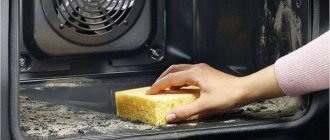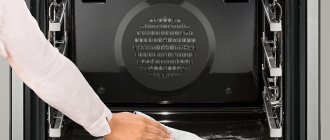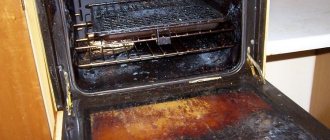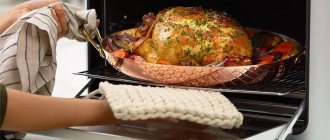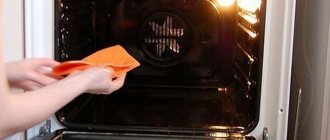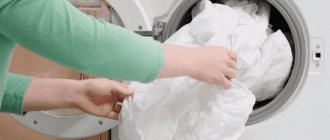EcoClean oven cleaning - what is it?
Many modern ovens have a self-cleaning function.
Based on the methods that help cope with fat and soot, methods are divided into several types. Classification and division of cleaning methods:
- Hydrolytic cleaning - Aqua Clean, Easy Clean.
- Catalytic - EcoClean.
- Pyrolytic.
Hydrolytic methods became the initial step towards creating “smart” ovens.
Specifics of the method: fat, carbon deposits are softened due to exposure to steam. All that remains is to wipe the walls. The difference between the Aqua Clean and Easy Clean methods is that in the first method, after steam treatment, the dirt softens and remains in the same place until manual removal. Easy Clean acts on grease with steam based on water and a special product, due to which all dirt settles at the bottom of the cabinet.
The catalytic cleaning system is a definite breakthrough in cleaning ovens.
External assistance, consisting of manual labor, is required only when cleaning the bottom and door, which do not have a special coating. The coating itself has a rough surface. The system was modernized by converting catalytic enamel panels to ceramic-coated panels - this is how EcoClean cleaning was born.
Distinctive features of catalytic surfaces and surfaces with the EcoClean system:
- Catalysis occurs during every preparation. Ecolyse is recommended for use after each preparation.
- The EcoClean function is responsible not only for the breakdown of fats, but also for the self-healing of the panels, which allows you to increase their service life.
- Removable panels responsible for catalysis are designed for 300 cycles. The eco wedge operates effectively throughout the oven’s service life, which is about 10 years.
The pyrolytic method reduces human participation to good preparation of the area, provision of ventilation and 5 minutes of treatment after exposure.
It involves burning fat and carbon deposits through exposure to high temperatures.
EcoClean Direct oven cleaning - what is it?
EcoClean Direct oven cleaning is an auto-cleaning system in which the walls of the oven absorb fat (contaminants) and break it down the next time it is heated.
Now let's figure it out.
So, having surfed the Internet, I found out that EcoClean Direct is a kind of technology for automatically cleaning an oven or shower cabinet. The trick is that the oven chamber is covered with a special coating - it is present on the back, top, and side walls. On some, this may not be true, it depends on the model. So, this coating absorbs fat during cooking. They absorb special microscopic ceramic particles, and then, during the next heating of the oven, they break down fat. It seems like a miracle, but this is exactly what the manufacturer claims about EcoClean Direct. In the end, what do we have? And the fact that the oven cleans itself throughout its entire service life.
The only thing is that, as I understand it, when the fat is broken down, a little debris will appear, which can be easily removed with a cloth:
In short, I’ll be honest - all this is doubtful, it’s hard to believe, we all know very well what fat contamination is... for example, after cooking a whole chicken in the oven. Therefore, this... so that it doesn’t get worse... for example, is it possible to ruin the surface if you wash the walls as usual? This is in case the expected effect from EcoClean Direct does not occur. Hand washing the surface with detergent can still cause harm, the coating may peel off, etc. All these points need to be clarified. So far, for me personally, EcoClean Direct looks like a miracle of know-how, that the oven cleans itself of grease, which sometimes we can’t easily remove with our hands from a frying pan that was previously soaked in water with detergent. So guys, be careful, consult with the seller, maybe it’s better to take a regular oven without this know-how.
So... everything is falling into place a little. So it turns out EcoClean Direct is not just a coating, it can be replaceable, these are special panels that can be ordered separately:
But in this picture, in fact, we see the whole secret:
PS: where the arrows are, this is the replaceable panel itself, which absorbs fat!
Firstly, these are replaceable panels, and secondly, they can be changed, that is, they simply protect the walls of the oven, but how long will they last? In general, guys, there is no super duper technology, you just have to regularly change these panels and that’s all)) but.. even if you don’t need to change, well, suddenly, it’s still easier to clean them, and not the walls of the oven.
I hope this information was useful. Good luck and good luck, see you again friends!
To home! 04/16/2021
Ctrl+C Ctrl+V - what does this mean? (control + c control + c) Grizzly folder - what is it? Mb3install - what is this folder? PORT. IN on the music center - what is it? Windows10UpgraderApp - what is it? scoped_dir - what is this folder? Windows10Upgrade - can it be removed? im_temp - what is this folder?
Hydrolysis method
- Aqua Clean. Operates at a temperature of 50 °C. It is proposed to pour 0.5 liters of water or a gentle detergent into a special container, after which you can close the door and wait for a click indicating the end of cleaning. As a rule, it will take about 30 minutes.
- Cleaning. For this you will need to preheat the oven to 90°C. Instead of water, a spray is used to protect the oven. This product must be used to treat the inner walls of the oven after the door clicks open. Cleaning lasts 15 minutes.
Cleaning is carried out within half an hour. First, water is poured into a specially provided round recess at the bottom of the oven; in some cases, gel is also added to it to create steam. When the oven heats up, the water evaporates and affects the fatty deposits on the inner walls. So, they soften and go into the pan.
After finishing the cleaning process, you need to remove all food residues with a napkin.
Hydrolysis cleaning is not an automatic method, since manual labor is not excluded when using it, however, it still makes the housewife’s work easier, as it helps remove fresh grease stains faster and without much effort. If they are already very dry, you cannot do without treating them with a cleaning agent and intense rubbing with a sponge.
Pros of hydrolysis:
- Low cost of the cleaning process - there is no need to spend money on expensive detergents and use a lot of electricity, since the process operates at low temperatures.
- Making the housewife's work easier.
- Safety – the doors do not overheat during cleaning.
Disadvantages of hydrolysis:
- After the cleaning process, some dirt remains that must be removed manually.
- Does not remove old stains.
- Cleaning is carried out only when the oven has completely cooled down. It should not be turned on immediately after cooking.
What other types of oven cleaning are there - all their pros and cons
The types of oven self-cleaning considered are additional functions that affect its cost. Before choosing a model, in order not to overpay extra money, you need to familiarize yourself with alternative cleaning methods.
You can use proven folk recipes while cleaning
An alternative method is enamel for easy oven cleaning: what is it, all the pros and cons
Manufacturers produce ovens whose surfaces are coated with easy-to-clean enamel. This is no longer a self-cleaning option; some effort will be required to care for the walls. However, this is better than the very simple coatings in older models. This enamel is available in both gas and electric ovens.
Easy to clean enamel has a smooth structure; it is enough to wipe it with a damp cloth using special household chemicals.
What is the cleaning process?
Manufacturers guarantee that with proper care, the enamel will last as many years as the oven. The coating is hygienic and has a glassy structure, which allows you to see all the internal surfaces of the equipment.
Regular surface care will extend the life of your oven.
Manufacturers' recommendations
Immediately after each cooking, when the oven has cooled down a little, you need to wipe the walls inside the cabinet with a damp sponge and detergent. The glassy structure of the coating prevents dirt from sticking, thereby facilitating surface care.
During the cleaning process, you can only use soft sponges and napkins.
Traditional oven cleaning - what is it and in what cases can you choose it?
As cleaning options, you should also consider the traditional options that our grandmothers used in the last century. At that time there were no household chemicals, and folk recipes were used. Such methods have their advantages and disadvantages.
Pros:
- saving money;
- With regular care, cleaning does not cause difficulties;
- saving electrical energy;
- components are found in almost every home.
Minuses:
- manual cleaning can take a lot of time;
- You need to clean the baking trays and racks separately. Having a dishwasher where you can load all the parts will make your work much easier;
- The inner walls of the oven may be damaged.
Traditional methods will require some effort
What not to use during cleaning
For cleaning, do not use aggressive substances that can damage the surface. You should also not use powdered abrasive compounds or metal scourers.
All work should be carried out with rubber gloves; after processing, you should leave the cabinet door open for a while so that foreign odors disappear
Folk recipes
You can clean the surfaces of the oven with a steam generator, its action is almost similar to the hydrolysis system, or use popular advice.
| Components | Oven cleaning instructions |
| Salt | Pour salt onto a baking sheet, place in the oven and turn it on at full power. When the salt darkens, turn off the cabinet and remove the deposits after lowering the temperature. |
| Laundry soap | Grate 50 grams of soap, moisten the mixture and rub all surfaces with it. After an hour, remove the coating and thoroughly wash the inside of the cabinet. |
| Soda | You can moisten a certain amount of powder and treat the inner walls with the composition. |
| Soda+vinegar | First treat the walls with vinegar, then with soda. You can wash off the plaque only after 3 hours. |
| Citric acid+soda+vinegar | For one packet of citric acid you will need 1 tablespoon of baking soda powder and half a glass of 9% vinegar. Mix all components, treat the walls and bottom with the composition, leave for half an hour. |
The principle of cleaning with a steam cleaner
EasyClean - easy cleaning
If we line up all the methods for self-cleaning ovens on a cost scale, then the most affordable will be cabinets whose internal walls are lined with special easy-to-clean enamels or special ceramic coatings.
Here, for example, is the Neff B1644 NO built-in oven with the EasyClean cleaning system (Fig. 1). To clean the cavity of this oven, you need to pour about 40 ml of water on its bottom (Fig. 2, a) and a few drops of a special detergent (Fig. 2, b). Now turn on the oven: within 21 minutes, the dirt will be treated with hot steam (Fig. 2, c), after which it will settle to the bottom of the cabinet (Fig. 2, d). All you have to do is collect them with a cloth (Fig. 2, e) - and your oven will shine clean (Fig. 2, f).
Rice. 1. Neff B1644 NO oven with EasyClean cleaning system
Rice. 2. Cleaning phases for Neff B1644 NO oven with EasyClean cleaning system
But technological progress has already moved further: ovens have appeared that continuously clean themselves. The ecoClean coating used to clean ovens is a true innovation from the BSH concern, marking the beginning of the era of nanotechnology. Surfaces with this coating are cleaned automatically throughout the cooking process, without requiring additional energy costs. But that's not all: ecoClean absorbs up to 80% of all odors, which leads to a noticeable improvement in the atmosphere in the kitchen. The ecoClean coating contains a weightless layer of microscopic ceramic beads that simultaneously break down sediment from the inside and out. The ability of the balls to recover during heating makes their cleaning power almost eternal.
The ecoClean cleaning system is used, for example, in ovens Siemens HE 380560, Siemens HE 365560, Bosch HBN 370650E (Fig. 3), etc. In most models, ecoClean coating is applied to the back wall of the oven, but as an additional option offered by the manufacturer, it can be application to the ceiling and side walls of the oven.
Rice. 3. Bosch HBN 370650E oven with ecoClean cleaning system
In recent years, coatings of this kind have gradually replaced traditional low-temperature cleaning systems based on catalytic panels from the market. This is understandable: the catalytic panel is a consumable material that must be replaced after a certain period of time. For example, the catalytic panels used in Candy ovens have a service life of over 300 hours. Ceramic coatings are designed to last the entire service life of the oven.
However, manufacturers of household appliances are in no hurry to part with traditional cleaning methods. Thus, SATA ovens use a total of four types of self-cleaning, to suit every taste and budget: the EasyClean easy cleaning system based on fine enamel, a catalytic cleaning system with removable panels, the Vetro Clean quick cleaning system based on enamel with a glassy coating and, finally, pyrolytic cleaning system.
Principle of operation
Catalysis is a chemical reaction that accelerates the breakdown of fats into carbon dioxide, water and organic residues. In the oven, this cleaning method is implemented using special panels that have a porous structure. They are covered:
- special fat-absorbing enamel;
- chemical catalysts - manganese, copper, cobalt or cerium oxide, which accelerate the breakdown reaction of fats;
- adsorbent.
Catalytic cleaning is carried out automatically and does not require constant monitoring or additional actions.
Contaminants are burned to ashes at a temperature of 140 degrees during normal operation of the device.
Cleaning mechanism
Self-cleaning of the oven using the catalysis method means accelerated breakdown of fats at a fairly low temperature (140–250 degrees) under the influence of special elements - catalysts applied to porous enamel.
Mechanism of action:
- The heating element heats the air and the surface of the oven.
- The fat formed during cooking settles on the catalytic panels and begins to burn out. The higher the temperature and the longer the baking time, the faster the transformation of dirt into soot will occur.
- Unburned particles do not eat into the walls of the oven. They can be washed as usual or left until the next time you use the device.
- The resulting soot should be wiped away with a damp cloth.
Features of ovens with catalytic self-cleaning method
Ovens equipped with a catalytic type of cleaning require careful operation and compliance with the rules of care
When choosing a device, it is important to remember that the coating is applied only to the back wall, side panels and convector blades. The cabinet bottom and glass door are not protected from grease.
The features of ovens with a catalytic system are usually specified by the manufacturer in the operating instructions for the device:
- The panels are valid for 3–5 years depending on the intensity of use. After this, they lose their cleaning properties and require replacement.
- For manual cleaning and removal of heavy dirt, it is permissible to use professional products without abrasives and soft sponges.
- The panels are available in 2 types: single-sided and double-sided. The type is indicated in the instructions. Double-sided ones last longer - after the recommended period has expired, they must be dismantled, turned over and installed in their original place.
- Do not allow large amounts of fat to get on the walls. Some of it may not burn and may settle on the walls of the oven. If the device is rarely used, such layers reduce the cleaning properties of the panels.
Some oven models have catalytic panels included as standard, but not installed. Before use, you must install the equipment yourself, following the manufacturer's instructions.
Catalytic filters and panels
Grease (catalytic) filters increase cleaning efficiency and reduce the amount of grease deposited on the oven walls.
They accumulate dirt in special containers, which then need to be washed with a cleaning agent.
Catalytic panels and filters differ in service life, catalyst concentration, catalysis coefficient (determines at what temperature the fat breakdown reaction will start). The parameters do not significantly affect the final cost of the device, but they determine the service life and the regularity of replacement of components.
How the system works
The EcoClean oven cleaning system is a real breakthrough in the field of nanotechnology. Fatty contaminants that fall on the surface during the cooking process penetrate into the porous structure of the coating. Internal cleaning of the panels does not occur during cooking, since the function starts only at elevated temperatures, not lower than 270 degrees.
Under the influence of temperature and thanks to a specially developed coating containing safe catalysts, fat is broken down, converted into carbon dioxide, water and organic residues. Complete cleaning occurs within 40 minutes, and the cleaning properties of the panels are restored.
Given the important differences regarding service life and coating, it is worth pointing out the external differences between the catalytic cleaning oven and the innovative EcoClean. Eco wedge panels are gray and thinner. Also pay attention to the location of the panels: they can be only on the sides, only on the back, or on the sides and on the back wall. The bottom is very rarely equipped with a function. Since the contaminants that fall down do not belong to the category of fats. Most often this is sugar, splashes of milk - they will have to be washed manually even with an eco-clean.
Pyrolytic oven cleaning: what is it?
Only electric models are equipped with this option; it cleans the oven from greasy contaminants, which is carried out automatically. The device independently cleans the cabinet walls from various types of dirt. Most of the built-in models are equipped with pyrolysis. Due to the heat-resistant materials from which the ovens are made, the kitchen set located near the equipment does not deteriorate.
Excess dirt on the walls burns off. The soot needs to be wiped off with a regular rag.
Operating principle
Self-cleaning occurs when heating elements are heated to 500 degrees. Due to high temperatures, excess dirt on the walls burns, turning into ash particles, after which it is necessary to wipe off the soot from the surface with a regular rag. During the purification process, catalytic filter elements are used to eliminate unpleasant odors resulting from pyrolysis.
Healthy!
There is no need to replace or clean the filters; they are designed to operate throughout the entire period of operation of the unit. The filter elements are cleaned using high-temperature annealing once every 100 hours of operation of the device.
Occurrence and types of pyrolytic cleaning
There are special requirements for the body of an electric stove: it must be made of high quality steel, because the oven heats up to 500 degrees. Heat-resistant metal resists deformation and protects nearby kitchen furniture. The oven is equipped with a reinforced door made of tempered glass, which opens using a tangential mechanism.
When this type of cleaning occurred, there were three modes, when the oven was heated to 500 degrees for 60 minutes. The holding time of the maximum temperature from 1 to 3 hours directly depends on the choice of the operating program, after which the unit cools down for 2 hours.
There are three types of pyrolytic cleaning:
- Minimal - used for a small amount of dirt, lasts for 2 hours 15 minutes;
- Normal is the most popular mode, which is most often used by housewives (2 hours 45 minutes);
- Intensive - designed for heavy dirt, greasy deposits, in this program the function works for 3 hours 15 minutes.
Varieties of pyrolysis are provided for varying degrees of contamination. Some oven models have several temperature settings. This factor allows you to save energy consumption.
Some modern devices are equipped with catalysts that determine the level of pollution. Thanks to this option, you can select the time range for wall treatment and the optimal degree of cleaning. All specified parameters are displayed on the device display.
Advantages and disadvantages
During the operation of kitchen appliances, it is always possible to identify positive and unfavorable factors. To select the most suitable unit, you should know all the criteria and technical characteristics.
Advantages:
- if we compare this type of purification with analogues (catalytic and hydrolysis technologies), this system is the most effective;
- there is no need to replace consumables, the filter elements are designed for the entire period of operation of the device and are self-cleaning;
- if cleaning is used frequently, the cost of additional cleaning agents is not required, and the appearance of unpleasant odors is reduced;
- during pyrolysis, the entire working surface of the oven is treated, and not individual parts, as in analogues;
- if sweet and dairy components get on the walls, this does not affect the quality of cleaning the chamber.
Flaws:
- upon completion of processing, it is necessary to remove the remaining ash manually;
- The components (grids, baking sheets) must be cared for separately by washing them with your own hands or in the dishwasher. They can become deformed when exposed to high temperatures;
- the cost of units with a pyrolytic cleaning system is significantly higher than that of other equipment;
- Only electric ovens, most often built-in types, are equipped with this function;
- requires manual start, does not work in automatic mode when preparing dishes;
- Quite a lot of electricity is consumed;
- it is possible to release unpleasant odors during pyrolysis.
Despite the large number of disadvantages, the pyrolytic system is in demand among most consumers. The automatic type of oven processing does not require additional control during the working process.
To avoid unpleasant odors, it is necessary to connect the hood while processing the internal surfaces. If cleaning is done regularly, then the release of odors will not be strong.
Oven cleaning systems
Almost everyone loves grilled chicken, but no one likes to clean the oven. After all, this work is dirty and thankless. And it doesn’t matter whether you wash the oven in the cheapest stove or an expensive built-in oven - a lot of time and effort will be spent, and after the next culinary masterpiece in the form of a spit-roasted pig, the oven will again become very dirty.
But not only housewives, almost all manufacturers of household appliances are very concerned about this problem and are trying to somehow solve it, or at least facilitate the cleaning process itself. Everything is used - various design solutions, such as retractable carts and removable doors, and coating the inner walls of ovens with all kinds of enamels. The highest achievement can be considered the presence of self-cleaning functions in the devices. Today, pyrolytic self-cleaning is considered the best.
Pyrolysis
If we analyze the word “pyrolysis” itself, we get: Pyr - fire, heat; Lysis - decomposition, decay, transformation. The essence of the method is extremely simple - the oven is heated to a temperature exceeding 480°C, fat and dirt burn and turn into ash, which then simply needs to be removed. Easy and clean, but... very expensive, since not all stoves and ovens can withstand repeated heating to such high temperatures. It’s not for nothing that experts call ovens and stoves with pyrolysis the “Mercedes” of ovens - all systems and the appliances themselves are made from the best materials using the best technologies. In addition, a number of additional measures are required to achieve maximum safety for the entire device during operation of this function.
Oven "Mercedes"
The material itself (steel) from which the stove or oven body is made is used only of the highest quality, otherwise the oven will sooner or later simply warp after such a load. Very good thermal insulation is used so that the outside of the device does not heat up to critical temperatures. In addition, an additional cooling system for the outer surface is installed, otherwise there is a danger of heating not only the stove or oven itself, but also nearby objects.
The glass in the door of ovens with pyrolysis is thick, tempered, and can withstand high temperature changes. Usually there are three, or even four. But despite this, the outer glass of the door can become very hot during pyrolysis, much more than during cooking, so there is a real possibility of getting burned.
Make sure that children do not approach the device during self-cleaning operation, and be careful yourself. The stove handles can also heat up to 80°C during pyrolysis cleaning. Additionally, systems are installed to prevent the combustion of fat in the oven. Since the combustion of sauce residues can produce toxic gases, special systems filter the smoke and ensure that these gases do not leave the appliance. The enamel that covers the inner walls of the oven is called “pyrolytic”. This means that it is designed for high temperatures, will not change color and will not lose its properties.
There is no smoke without fire
During pyrolytic cleaning, the oven produces a lot of smoke, so to keep the air in the kitchen clean, it is advisable to provide a special smoke outlet directly into the ventilation system. To do this, there is a separate outlet on the back wall of the appliances, where you can connect a tube through which the smoke will escape without entering the air in the kitchen.
A regular hood, even a very powerful one, may not be enough. To reduce smoke, some manufacturers install special catalysts (for Miele, for example, the active substance of the catalyst is platinum) and grease-absorbing filters, which, when installed in the area of the convector, also protect its blades from grease contamination.
The cleaning process itself occurs when the oven door is automatically locked. The lock will turn off when the temperature inside (center) drops below 3500°C. Accordingly, the locking mechanism itself is installed very reliable, which will not break under such loads. You can only turn on the device after cleaning manually; the programmer will not work.
In terms of time, a full pyrolytic cleaning cycle takes from 90 to 150 minutes. In this case, most of the time is spent heating and cooling the oven. In some devices, a special catalyst detects the degree of contamination and controls the duration of the process (Miele). In other models, you can choose a full or economic oven cleaning cycle (some AEG models).
Don't forget to take out the dishes
Naturally, during the operation of the self-cleaning mode, a large amount of electricity is consumed. But given the cheapness of Russia, these costs are quite small, because devices with pyrolytic self-cleaning can only be afforded by very wealthy people, for whom an extra 15-20 rubles. for electricity are not an unaffordable expense. And yet, the pyrolysis mode is a heavy load for the device. Therefore, it is advisable to use it only when the inner surface of the oven is heavily soiled.
Manufacturers, as a rule, warn in their instructions that before carrying out pyrolysis cleaning, it is necessary to remove the baking sheets, telescopic guides and baking sheet holders from the oven so that they do not deteriorate. But that’s why they are rules, so that there are exceptions to them. Siemens engineers asked the question: if the oven can be cleaned using pyrolysis, then why not clean baking trays and grill trays in the same way? Therefore, baking sheets covered with heat-resistant enamel in some models from Siemens can not be removed from the oven during pyrolysis, but left there, they will also become clean. But don’t rush to use an ordinary enamel saucepan for cleaning; nothing good will come of it.
Where to look?
Pyrolytic cleaning is more common in built-in ovens than in freestanding ranges. This is due to the fact that built-in stoves are more intended for wealthy people than “solo” stoves - therefore, all advanced technologies are actively used in this area. On the Russian market, models of ovens with pyrolysis are offered by many companies: AEG, Ariston, Brandt, Electrolux, Miele, Smeg, Siemens, etc.
Prices for ovens with pyrolytic cleaning range from $650 to $4,000 depending on other features. Prices for free-standing slabs with pyrolytic cleaning start from $700, but the choice of models is very scarce (Siemens HL 56024)
Catalytic purification
This method does not require serious complication of the design of the equipment, therefore it is used much more often, both with free-standing stoves and with built-in ovens from a variety of manufacturers.
The essence of the method is this: the walls of the oven are covered with special enamel, which is a dark, finely porous, rough material, in the pores of which the maximum amount of fat settles. The catalytic properties of the panels make it possible to accelerate the processes of fat oxidation with atmospheric oxygen, and at high temperatures (2000°C or more) the fat decomposes into carbon (soot) and water. The self-cleaning process occurs directly during the preparation of any dish. The degree of cleaning is not as high as with pyrolysis, and large stains of grease may disappear only after repeated use of the oven.
Typically, catalytic enamel is used to cover the back and side walls of the oven, and sometimes the fan blades. As a rule, it is not used for the lower part. This is due to the fact that catalytic enamel does not like sugar and milk. And when baking pies with jam, a situation in which the filling leaks onto the lower baking sheet is quite likely. The oven “floor” will have to be washed the old fashioned way. And yet, the life of housewives is greatly simplified, because you don’t have to reach the hard-to-reach back wall with a rag and “scrub” the side ones. By the way, if you decide to wash an oven with catalytic enamel in the traditional way, do not use abrasive powders or rough rags.
Just for five years
Another feature of the catalytic coating is that over time it loses its wonderful properties and will have to be replaced. This usually happens after 4-5 years of active use. Of course, if you roast meat in the oven three times a day, this will happen faster. Fortunately, almost all manufacturers now use removable panels. Once you feel that the oven is starting to get dirty, you can simply replace the old panels with new ones. Very often you can cope with this task yourself; you just need to disconnect the fasteners or unscrew the bolts, and the panels can be easily removed (the instructions tell you how to do this). If you are not confident that you can do everything correctly, then it is better to contact the service.
Some manufacturers use double-sided coatings. In this case, after the enamel has worn off on one side, you just need to move the panels to the other side. The catalytic coating in ovens from different manufacturers has the same properties, since it is purchased by stove manufacturers from manufacturers in finished form and then applied to the walls of the ovens. And the number of manufacturers of catalytic enamel is limited.
Ovens and freestanding stoves with catalytic cleaning are quite easy to find on sale. Almost every manufacturer has models with this function. Of course, more often catalytic panels are installed in electric stoves, but you can also find gas ovens that are equipped with this function (for example, the free-standing Bosch HSF 142 C RF stove). The price of stoves and ovens with a catalytic coating is significantly lower than that of appliances with pyrolysis, averaging $500 - $600. By the way, in stores, sometimes sellers for some reason do not install panels on the walls of the oven; they can simply lie on baking sheets in their packaged form. Therefore, ask the seller about the self-cleaning function and carefully look at everything that is in the oven.
Ecoclean function
At the beginning of 2004, Bosch ovens were introduced with a new type of replaceable panels, developed using nanotechnology. The ceramic coating, which ensures self-cleaning of the oven walls, is called EcoClean.
During cooking, fatty contaminants penetrate into the cellular structure of the enamel, like a sponge, and are broken down into carbon dioxide and water at a temperature of 2700°C. If cleaning did not occur directly during cooking, then it is recommended to turn on the oven for 45-50 minutes. During this time, the enamel is cleaned and completely restores its properties.
The main difference between the new Ecoclean coating and catalytic panels is durability. The enamel retains its properties throughout the entire operating life of the oven (10 years). In addition, the new panels differ in appearance - they are thin and gray in color. According to the manufacturers, fat breaks down faster in them, since it is “absorbed” by the enamel rather than spreading over the surface.
As can be seen from all of the above, the choice of methods for self-cleaning ovens today is small, but still a worthy alternative to a rag with powder has already appeared. It is also important that owners of both electric and gas ovens with varying degrees of material income can afford to buy ovens with a self-cleaning function.
“Aqua Clean” cleaning system
Gorenje specialists went their own way, offering the “Aqua Clean” automatic pollution removal system. In this case, ovens are cleaned using water. Should I pour it into a deep pan? liter of ordinary water, turn on the “bottom heating” mode, set the thermostat to 500 C and leave it like that for half an hour. Water, slowly evaporating, will soften the pollution. Then it will be enough to simply wipe the inner surface with a soft cloth. Naturally, the enamel used in such models is high-quality, acid-resistant, even and smooth. It has the “brand” name Ecoclean and belongs to the group of enamels with an acidity level of “AAA”. Its molecular structure prevents fat from penetrating inside. Ardo specialists also recommend cleaning ovens that are heavily soiled. True, they do not highlight this as a separate function, but simply suggest using this method to make it easier to wipe off fat. The advantages of this cleaning method are obvious - easy, cheap and without the use of aggressive chemicals. But calling the “Aqua Clean” function “self-cleaning” can only be partly possible, because strong grease stains cannot be removed, and besides, housewives will have to wipe the entire inner surface of the oven with a rag, that is, wash it, and doing this under the grill is not so easy . Some experts believe that this is simply one of the ways to make maintenance easier, which can be used by all owners of ovens coated with high-quality enamel.
As can be seen from all of the above, the choice of methods for self-cleaning ovens today is small, but still a worthy alternative to a rag with powder has already appeared. It is also important that owners of both electric and gas ovens with varying degrees of material income can afford to buy ovens with a self-cleaning function.
Source: “Purchase” magazine / April-May 2004/
Hydrolysis oven cleaning
Most likely, this simple but quite effective cleaning method is a folk invention, because every housewife who has had to wash dried dirt from dishes is familiar with it. The essence of the method is the preliminary softening of fats that have reached the walls of the oven, for which water steam is used. To do this, simply take one or two containers of water and place them inside the oven. Then the oven is heated to 50-90 °C and after 30-40 minutes it will be much easier to clean off greasy stains or pies that have dripped onto the bottom of the oven.
In fact, oven manufacturers did not invent a wheel, but simply made a recess in the oven bottom where you can pour water, added a timer for 30-40 minutes and said that such ovens are equipped with a hydrolysis cleaning system. Additionally, for such ovens they began to sell cleaning products that help soften fats and burnt dough under the influence of hot steam.
To the credit of the manufacturers, they did not stop there - the cleaning method itself is unlikely to be improved, but the enamel for oven walls is gradually improving. Its acid resistance increases, and the even and smooth surface has a molecular structure that prevents fat particles from penetrating into it.
+ Advantages of the hydrolysis cleaning method
- Extremely economical - you only need water and a little detergent. Energy costs are minimal since there is no need to heat the oven to high temperatures.
- Safety – no overheating and no danger of getting burned.
- Despite the simplicity and obviousness of this solution, it significantly increases the cleaning efficiency.
– Disadvantages of the hydrolysis method of purification
- You will still have to work hard on complex contaminants.
- You have to set aside separate time for cleaning. In this case, the oven must be cooled down after cooking.
- The method, even by stretch of the imagination, cannot be called automatic - rather, it is simply a simplification of manual cleaning.
Pros and cons of pyrolysis ovens
In fact, models with such self-cleaning have a lot of advantages. The only question is how accessible these ovens are to a particular consumer. But if material possibilities allow, such ovens undoubtedly deserve our attention, because their positive qualities are difficult to overestimate.
- An oven with pyrolytic cleaning is, above all, the highest quality and enviable durability. Such an assistant will serve faithfully for decades without breakdowns.
- The cleaning is carried out by a built-in program; a person does not need to scrub the dirt for a long time and thoroughly - they save energy, time, and cleaning products, which, moreover, during this period do not have a negative effect on the hostess’s body.
- Pyrolysis self-cleaning allows you to remove even very stubborn contaminants from the most inaccessible places.
- Unlike other cleaning systems (the same catalytic ones), special filters for neutralizing specific odors that arise will not need to be changed even after 4–6 years of operation of the oven.
- Models of electric ovens equipped with a pyrolysis self-cleaning function have a very diverse and attractive design, with perfectly smooth enamel on all internal surfaces.
In addition, in standard housewife models, three main pyrolytic cleaning modes are available: from minimal to intensive, lasting respectively from 2 hours 15 minutes to 3 hours 30 minutes. This allows you to select a mode depending on the degree of contamination. To save power on the oven, there is a special energy-saving mode that is useful for simple contamination.
As for the disadvantages, such cabinets have relatively few of them, but some of them are quite significant:
- Quite a high price compared to conventional models.
- Sometimes unpleasant odors can still arise, so it is recommended to additionally turn on the hood during the cleaning procedure.
- When purchasing, you need to find out what temperature the external surfaces reach during cleaning, so that you can arrange furniture and other equipment accordingly.
- The pyrolytic process is only possible in electric oven models. It is simply impossible to achieve an increase in temperature to such levels with gas ones.
- During pyrolysis cleaning, much more electricity is consumed, and a considerable part of it is spent on “accelerating” the heating element to the desired temperature, because the reaction itself begins only after it is reached.
Advantages and disadvantages
The catalytic cleaning method is perhaps the most advantageous when compared with hydrolytic and pyrolytic methods. And the EcoClean cleaning system is an improved version of the method, having a special, improved ceramic coating.
Advantages of the system based on comparative characteristics with other “smart” methods:
Energy consumption and time costs:
- The amount of energy consumed is small - up to 270 degrees for 30-40 minutes. Which gives grounds to equate the method with the hydrolytic method in terms of costs - similar duration, but at different temperatures.
- The pyrolytic method is an outsider in terms of energy consumption - the costs significantly exceed the amount of electricity consumed when using the EcoClean system. And if the catalytic system only requires the presence and installation of panels, then for an oven with a pyrolysis function you will have to install a power cable and provide good ventilation.
- All methods, except catalysis, are carried out separately from cooking. But unlike EcoClean, which requires 30-40 minutes, pyrolytic cleaning takes 60-150 minutes.
Versatility - the Aqua, Easy and EcoClean systems are suitable for both electric and gas stoves. During pyrolysis, the temperature level can reach up to 500 °C, so gas ovens of the method are dangerous.
Cost - fat-burning enamel, as well as the EcoClean coating, are included in the middle price segment when compared with the types of ovens under consideration.
Unpleasant odor – EcoClean has the ability to absorb odors. How does it benefit from pyrolysis, which is unthinkable without good ventilation? However, the odor is not completely absent, as is the case with hydrolysis and catalysis. Absorbed up to 80%.
The only disadvantage of the EcoClean system is that it does not completely cover the surfaces of the oven. The defect can be corrected independently using additional removable panels. Missing panels will require manual cleaning on non-equipped parts. In this regard, the pyrolytic method clearly wins, as it burns contaminants to ash - all that remains is to remove the “dust”.
The Ecoclean feature takes catalysis to the next level, increasing service life, safety and efficiency.
Advantages of the method
Since catalytic purification is a simple chemical reaction, it does not require complex technologies or expensive components. Therefore, such a system stands out among developments at an affordable price. In addition, it has a number of other advantages:
- significantly saves time spent on stove maintenance;
- the oven does not need to be washed after each cooking;
- cleaning occurs while cooking, so it does not require additionally turning on the oven and wasting electricity or gas;
- The warranty period for the enamel is about 5 years.
Over time, the protective coating wears off and must be replaced with a new one. In some models of equipment, the walls are treated with catalytic enamel on both sides. In this case, they need to be turned over to the new side. You can easily carry out the manipulation yourself, as the instructions describe the procedure in detail. But if a person is not able to cope with the work, the service center employees will quickly reinstall the walls.
When using catalytic cleaning, you do not need to select a special place in the kitchen to install the oven. The system works without interruption everywhere and does not heat the stove to such an extent as to damage furniture or other household appliances in the immediate vicinity.
Features of catalytic cleaning
Catalytic purification is a milder version of the pyrolytic method. The main difference is the removal of fatty deposits during oven operation. This saves time and does not require a special procedure. However, over time, the catalyst loses its performance, which forces users to renew the coating.
As a rule, special material is applied only to the inner walls of the oven, excluding the bottom and glass door. These areas are equipped with removable panels coated with enamel with catalytic properties. The glass door and bottom of the cabinet are cleaned using the traditional method. This is inconvenient, but there is no other way to solve the problem.
The specificity of catalytic cleaning is such that enamel can be used in any type of oven - both electric and gas. The service life of the enamel is approximately 300 hours, after which the effect decreases. In such situations, the panels are replaced, and if double-sided planes were initially installed, they are simply turned over to the other side.
Ovens with catalytic surface cleaning are labeled EcoClean. This is a trade designation for the technique. When choosing the right model, you need to take into account the terminology used to avoid confusion. For example, hydrolysis cleaning systems are labeled EasyClean, which looks similar and may cause an error. It is recommended to consult with the seller to clarify how to clean the product.
Mechanism of operation of the system
To begin the procedure, place a baking tray in the oven with a small amount of clean water (usually half a liter is enough), to which a special cleaning agent is added. Next, turn on the oven for half an hour, having previously set the temperature from fifty to ninety degrees Celsius.
The steam generated acts on contaminants (including stubborn and complex ones) during the washing process. Hydrolytic cleaning requires it to soften and dissolve grease and other types of tough stains.
After the action of the washing steam has passed, the remaining dirt is cleaned out manually using soft rags and medium-hard sponges. You can also use soft plastic brushes.
Important:
